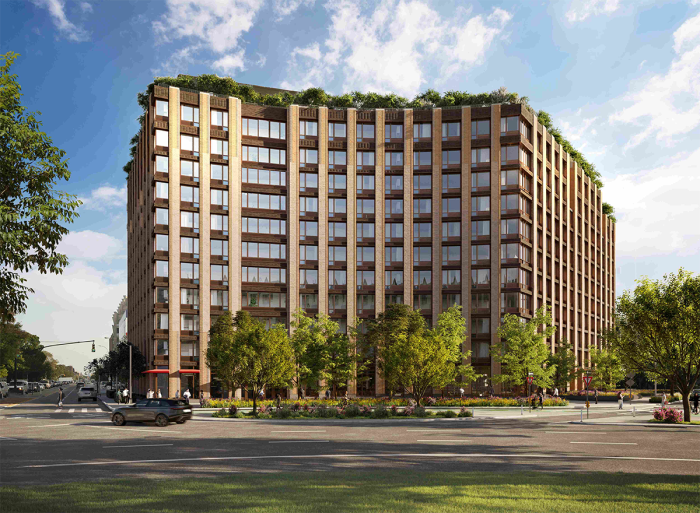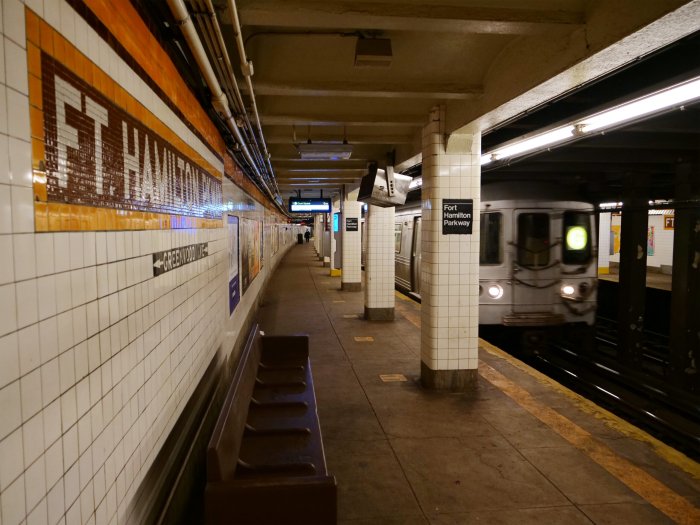To walk, or to park: that is the question.
Owners of property along a stretch of Prospect Park West may have to sacrifice street parking in order to repair a treacherous brick sidewalk that locals continue to stumble and injure themselves on, according to a leader of the Department of Transportation.
The agency’s borough commissioner Keith Bray announced the Sophie’s Choice to a crowd of residents and business owners during a public meeting on Tuesday, claiming that in order for the city to fund repaving the dangerous walkway that runs from Bartel Pritchard Square to 18th Street, any project would have to include traffic-safety improvements in the form of sidewalk extensions that would gobble up parking and narrow the roadway near intersections — a compromise that some locals called a no-brainer.
“For the good of the community, if it’s between a parking space or a person being crippled or killed by a hard fall, I would vote to give up parking spaces,” said Don Kent, who owns a building on Windsor Place a few doors down from Prospect Park West. “Which is more important: a parking space or someone’s life?”
Workers installed the brick sidewalk in 1987 and residents strolled it without issue for about a decade, said area property-owner Scott Nagel, who served as the head of the Prospect Park West Merchants Association when the masonry was first laid.
The path eventually fell into disrepair, but proved far more difficult to maintain than its concrete counterparts, according to the local, who estimated he spends an average of $200 per year repairing the bricks outside his building — as opposed to an average of $400 per decade that he guessed he would pay for upkeep of concrete.
Another Prospect Park West property owner, Maureen Pynn, claimed fixing masonry that was dislodged by a tree root outside her lot cost her $3,000 last year alone.
And even with regular maintenance, the sidewalk’s bricks remain a constant hazard to pedestrians — especially seniors — many of whom suffered nasty falls over the years, according to Kent, who said his 75-year-old neighbor got five stitches after taking a spill and that he met a younger man who broke his knee tripping over a loose block.
But not all locals welcomed Bray’s solution requiring the installation of sidewalk extensions known as bump-outs, and Nagel said he’d rather get a group of fellow property owners to fund repaving the walkway, or find another fix that doesn’t sacrifice parking.
“It’s a great idea to ask the city for money, but I think that the bump-outs are probably a very bad idea,” he said. “I’d be happy to chip in 50–50 to fix the whole thing. If I put in $1500 and the city ponies up the difference, I’d be happier than getting bump-outs.”
And Pynn said that if officials restrict the number of extensions per block to one or two, residents might be more amenable to installing them.
“We’d probably want the bare minimum, because parking is such a big issue,” she said. “Why would we give up two spaces when you can give up half a space.”
Bray couldn’t say how many bump-outs would be necessary or how large they’d have to be in order for the city to fund a sidewalk makeover.
The meeting’s organizer, Assemblyman Robert Carroll (D–Park Slope), promised to arrange more sessions to discuss the issue, at which transit agency reps would be expected to present a more specific thoroughfare-refurbishment plan.
But any proposal that calls for cutting parking will likely divide the community, according to Nagel, who said residents will have to come to a consensus before the city ponies up any dough to fix the sidewalk.
“This process is going to drag on,” he said. “You’re going to have a strong group that doesn’t want to spend any money, regardless of the parking consequences. And there will be others who want to have more control over their destiny, and will pay to have it done.”





















